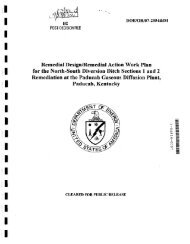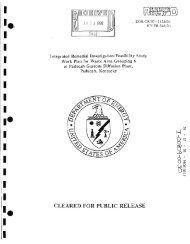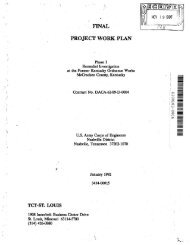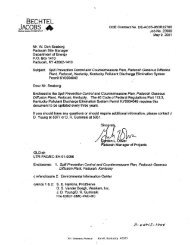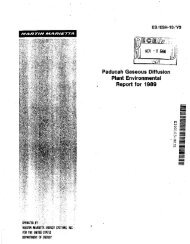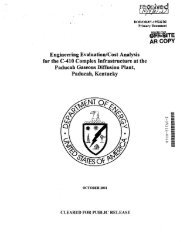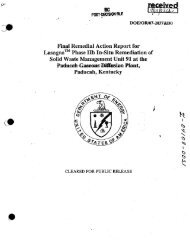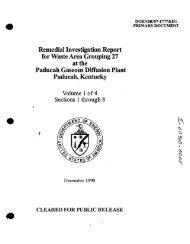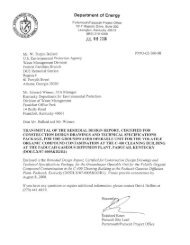1 - paducah environmental information center
1 - paducah environmental information center
1 - paducah environmental information center
Create successful ePaper yourself
Turn your PDF publications into a flip-book with our unique Google optimized e-Paper software.
Annual Site Environmental Report for 1999<br />
Abstract<br />
The primary ob~ectives of groundwater ,monitoring at the Paducah Site are to detect contamination and<br />
provid~ the basIs for ground~ater quality assessments if contamination is detected. Monitoring includes<br />
the ~Xlt pathways at t~e pe,,'!"eter of th~ plant and off-site water wells. Primary off-site contaminants<br />
contmue to be TeE, an mdustflal degreasmg solvent, and 99 Tc, a fission by-product. Evidence suggests the<br />
presence of dense nonaqueous phase liquids (DNAPL) on-site.<br />
Introduction<br />
Monitoring and protection of groundwater<br />
resources at the Paducah Site are required by<br />
federal and state regulations and by DOE orders.<br />
Federal groundwater regulations generally are<br />
enacted and enforced by EPA. The Paducah Site<br />
lies within EPA Region N jurisdiction. EPA<br />
Region N encompasses the southeastern United<br />
States and maintains headquarters in Atlanta,<br />
Georgia. Many state groundwater regulations<br />
are enacted and enforced by KDWM in<br />
Frankfort, Kentucky. A KDWM field office for<br />
western Kentucky is located in Paducah.<br />
When Offsite contamination from the<br />
Paducah Site was discovered in 1988, the -EPA<br />
and DGE,entered i into 'an ACO. DOE provided<br />
an alternate water supply to affected· residences.<br />
Under CERCLA, IDOE is also required to<br />
determine the nature and extent of offsite<br />
contamination through sampling of potentially<br />
affected wells and a comprehensive site<br />
investigation.<br />
A CERCLAI ACO site investigation,<br />
completed in 1991, determined offsite<br />
contaminants in the RGA to be TCE, used as an<br />
industrial degreasing solvent, and 99'fc, a fission<br />
byproduct contained in nuclear power reactor<br />
returns that were brought on-site several years<br />
ago for reenrichment. Such reactor returns are<br />
no longer enriched. Known or suspected<br />
sources of TCE and 99'fc include burial grounds,<br />
former test areas and other facilities, spills, leaks,<br />
and leachate derived from contaminated scrap<br />
metal.<br />
Investigations into the onsite source areas<br />
of TCEat the Paducah Site are ongoing. A<br />
common degreasing agent, TCE is considered a<br />
dense non~aqueous phase liquid (DNAPL).<br />
DNAPLs typically have low solubilities in water<br />
and sink to the bottom of aquifers or come to rest<br />
upon a less permeable layer within an aquifer,<br />
fomiingpools. These DNAPL pools form a<br />
continuing source for dissolved-phase<br />
contamination (plumes) that are migrating<br />
offsite toward the Ohio River (Figure 9.1).<br />
DNAPL pools are extremely difficult to clean up<br />
and currently only the highest concentrations of<br />
dissolved TCE are controlled by pump-and-treat<br />
Groundwater<br />
9-1



